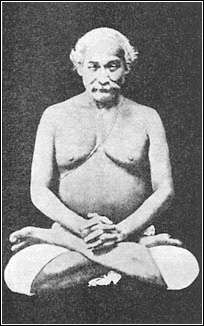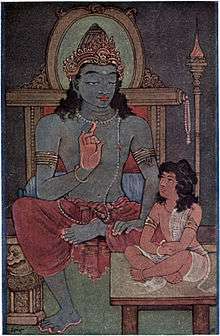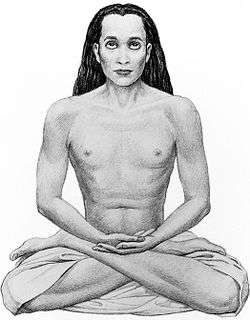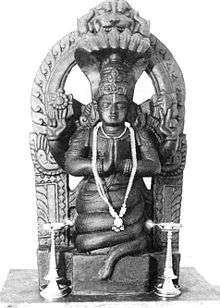Kriya Yoga
| Kriya Yoga | |
|---|---|
|
Mahavatar Babaji | |
| Founder | Mahavatar Babaji transmitted to Lahiri Mahasaya |
| Established | 1861[1] |
Kriya Yoga (क्रिया योग) is described by its practitioners as the ancient Yoga system revived in modern times by Mahavatar Babaji through his disciple Lahiri Mahasaya, c. 1861. Kriya Yoga was brought to international awareness by Paramahansa Yogananda's book Autobiography of a Yogi[2] and through Yogananda's introductions of the practice to the west from 1920.[3]
According to Yogananda the ancient Yogic text the Yoga Sutras of Patanjali, contains a description of Kriya Yoga in the second chapter II.49:[4] "Liberation can be attained by that pranayama which is accomplished by disjoining the course of inspiration and expiration."[5]
The Kriya yoga system consists of a number of levels of pranayama, mantra, and mudra based on techniques intended to rapidly accelerate spiritual development[2] and engender a profound state of tranquility and God-communion.[5] Yogananda attributes his description of Kriya Yoga to his lineage of gurus, Sri Yukteswar Giri, Lahiri Mahasaya, and Mahavatar Babaji (fl. 1860s). The latter is reported to have introduced the concept as essentially identical to the Raja Yoga of Patanjali and the concept of Yoga as described in the Bhagavad Gita.[5]
Practice


Kriya Yoga, as taught by Lahiri Mahasaya, is traditionally exclusively learned via the Guru-disciple relationship and the initiation consists of a secret ceremony.[6][2] He recounted that after his initiation into Kriya Yoga, "Babaji instructed me in the ancient rigid rules which govern the transmission of the yogic art from Guru to disciple."[7]
As Yogananda describes Kriya Yoga, "The Kriya Yogi mentally directs his life energy to revolve, upward and downward, around the six spinal centers (medullary, cervical, dorsal, lumbar, sacral, and coccygeal plexuses) which correspond to the twelve astral signs of the zodiac, the symbolic Cosmic Man. One half-minute of revolution of energy around the sensitive spinal cord of man effects subtle progress in his evolution; that half-minute of Kriya equals one year of natural spiritual unfoldment."[5]
In Kriya Quotes from Swami Satyananda, it is written, "Kriya sadhana may be thought of as the sadhana of the 'practice of being in Atman'".[8]
History
Yogananda wrote in God Talks With Arjuna: The Bhagavad Gita that the science of Kriya Yoga was given to Manu, the first man according to the Vedas, and through him to Janaka and other royal sages.[9] According to Yogananda, Kriya Yoga was well known in ancient India, but was eventually lost, due to "priestly secrecy and man’s indifference".[5] Yogananda says that Krishna refers to Kriya Yoga in the Bhagavad Gita:
Offering inhaling breath into the outgoing breath, and offering the outgoing breath into the inhaling breath, the yogi neutralizes both these breaths; he thus releases the life force from the heart and brings it under his control.[10]
Yogananda also stated that Krishna was referring to Kriya Yoga when "Lord Krishna ... relates that it was 'he', in a former incarnation, who communicated the indestructible yoga to an ancient illuminato, Vivasvat, who gave it to Manu, the great legislator. He, in turn, instructed Ikshwaku, the father of India’s solar warrior dynasty."[5] And again when he says,"Liberation can be accomplished by that pranayama which is attained by disjoining the course of inhalation and exhalation."[5] A direct disciple of Sri Yukteswar Giri, Sailendra Dasgupta (d. 1984) has written that, "Kriya entails several acts that have evidently been adapted from the Gita, the Yoga Sutras, Tantra shastras and from conceptions on the Yugas."[6]
Recent history
The story of Lahiri Mahasaya receiving initiation into Kriya Yoga by the yogi Mahavatar Babaji in 1861 is recounted in Autobiography of a Yogi. [11] Yogananda wrote that at that meeting, Mahavatar Babaji told Lahiri Mahasaya, "The Kriya Yoga that I am giving to the world through you in this nineteenth century, is a revival of the same science that Krishna gave millenniums ago to Arjuna; and was later known to Patanjali, and to Christ, St. John, St. Paul, and other disciples." Yogananda also wrote that Babaji and Christ were in continual communion and together, "have planned the spiritual technique of salvation for this age."[2][7]
Through Lahiri Mahasaya, Kriya Yoga soon spread throughout India. Yogananda, a disciple of Sri Yukteswar Giri who was himself a disciple of Lahiri Mahasaya, then brought Kriya Yoga to the United States and Europe during the 20th century.[5]
Lahiri Mahasaya's disciples included his sons, Dukouri Lahiri and Tinkouri Lahiri, Sri Yukteswar Giri, Panchanan Bhattacharya, Pranabananda, Kebalananda, Keshavananda Brahmachari, Bhupendranath Sanyal(Sanyal Mahasaya) and many others .[12]
Shailendra Sharma who is a disciple of Sri Satya Charan lahri (son of Tinkouri Lahiri) became authorised to initiate seekers into Kriya Yoga on April 28th 1984 and has since authored numerous commentaries on classic Hindu & yogic texts. Shailendra Sharma has also been directly taught by Babaji.
See also
Notes
- ↑ "Kriya Yoga 150th anniversary of the revival of Kriya Yoga".
- 1 2 3 4 Miller, Timothy (1995). America's Alternative Religions. SUNY Press. p. 178/183. ISBN 0791423972.
- ↑ "The Kriya Yoga Path of Meditation".
- ↑ Patanjali, Translator, Chip Hartranft (2003). The Yoga-Sutra of Patanjali: A New Translation with Commentary (Shambhala Classics). ISBN 1-59030-023-8.
- 1 2 3 4 5 6 7 8 Yogananda, Paramahansa (1997). Autobiography of a Yogi- Chapter 26 - The Science of Kriya Yoga. Self-Realization Fellowship. ISBN 0876120869.
- 1 2 Dasgupta, Sailendra Bejoy (2011). Kriya Yoga, its dissemination, and the Mahamuni Babaji Maharaj - Chapter 5 & 8. Yoga Niketan.
- 1 2 Yogananda, Paramahansa (1997). Autobiography of a Yogi- Chapter 33 - Babaji, Yogi-Christ of Modern India. Self-Realization Fellowship. ISBN 0876120869.
- ↑ Satyananda, Swami (2006). A Collection of Biographies of 4 Kriya Yoga Gurus by Swami Satyananda Giri - Kriya Quotes from Swami Satyananda Giri (translated by Yogi Niketan). iUniverse. ISBN 978-0595386758.
- ↑ Paramahansa Yogananda (1995). God Talks with Arjuna: The Bhagavad Gita (Chapter V), First Edition. Self-Realization Fellowship (Founded by Yogananda). ISBN 0-87612-030-3.
- ↑ Bhagavad Gita IV:29
- ↑ Yogananda, Paramahansa (1997). Autobiography of a Yogi- Chapter 34 - Materializing a Palace in the Himalayas. Self-Realization Fellowship. ISBN 0876120869.
- ↑ Yogananda, Paramahansa (1997). Autobiography of a Yogi- Chapters 3, 32, 33, 36. Self-Realization Fellowship. ISBN 0876120869.
External links
| Wikisource has original text related to this article: |

